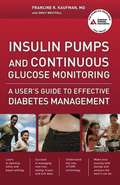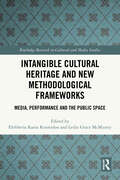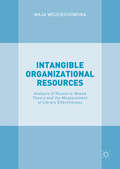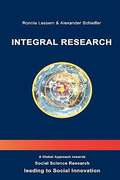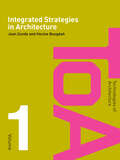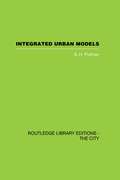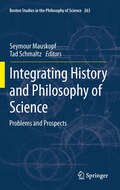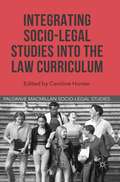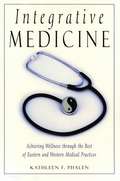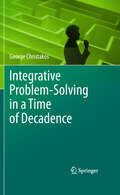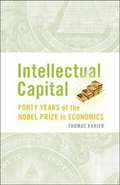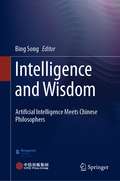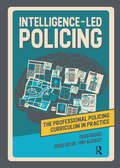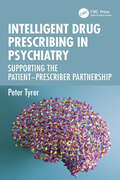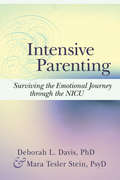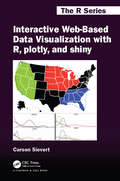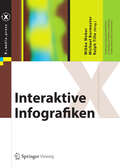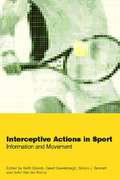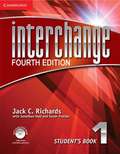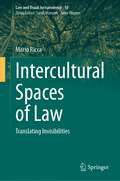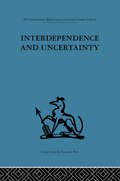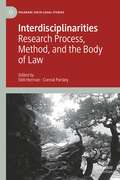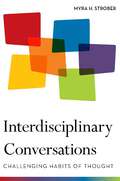- Table View
- List View
Insulin Pumps and Continuous Glucose Monitoring
by Francine R. KaufmanA diabetes diagnosis no longer means giving up an active life. New technology, such as insulin pumps and continuous glucose monitors, can help people with both type 1 and type 2 diabetes stay active and flexible and maintain healthy attitudes and lifestyles. Insulin Pumps and Continuous Glucose Monitoring explains how this new technology can dramatically improve care, as well as how to prepare for the physical and psychological challenges that come with these new regimens. It provides a comprehensive medical approach to diabetes management and pump therapy with an appreciation for the real-life challenges and frustrations faced every day by people with diabetes. By offering greater flexibility and control, insulin pumps and continuous glucose monitors are revolutionizing glucose management for people on insulin therapy. Dr. Kaufman's book shows how people with diabetes can use this technology to improve not only their diabetes care, but their lives as well.
Intangible Cultural Heritage and New Methodological Frameworks: Media, Performance and the Public Space (Routledge Research in Cultural and Media Studies)
by Eleftheria Rania Kosmidou Leslie Grace McMurtryThis book examines media, performance, and the public space as sites of intangible cultural heritage – a heritage that moves beyond physical museums and monuments to encompass film and media, performing arts, oral traditions, social practices, rituals, artifacts, and cultural spaces.Focusing on the current methodological challenges and new frameworks that surround the study of intangible cultural heritage in the public space, this volume explores the ways in which intangible cultural heritage is formed, represented, appropriated, and changed. The authors propose a broad understanding of cultural heritage emerging from the public sphere, encompassing museums, oral traditions, performing arts, social practices, artifacts, media and cultural spaces as the inclusive, collective cultural expressions of everyday culture.This unique and interdisciplinary volume will interest scholars and students of cultural studies, cultural heritage, media and film studies, performance studies, history, and sociology.
Intangible Organizational Resources
by Maja WojciechowskaThis book addressesthe challenges of organizing modern-day institutions, focusing on themanagement of intangible organizational resources of libraries through bothlibrary science and management theory. Highlighting new informationrequirements, knowledge transfer technologies and changing patterns of social behaviour,Intangible Organizational Resources exploreshow these changes are affecting the organization of information services suchas libraries, and discusses what they mean for the effectiveness and quality oftheir services. Making a unique contribution in an otherwise under-exploredfield, this is an essential text for those involved in the organization ofinformation services.
Integral Research: A Global Approach towards Social Science Research leading to Social Innovation
by Ronnie Lessem Alexander SchiefferThe author argues that essential humanism in the social sciences research domain have been super-ceded by rationalism and pragmatism and this does not contribute towards the burning social issues of our time.
Integrated Strategies in Architecture (Technologies of Architecture)
by Joan Zunde Hocine BougdahThis key text presents students with a holistic view of the building design process, bridging the gap between the theory and practice of constructing and assembling buildings. Integrated Strategies in Architecture encourages and enables students to gain a sound understanding of the purpose of buildings, the specialisms that contribute and the available technology. Zunde and Bougdah thoroughly introduce and expose the concepts and technologies that underlie the design process, setting current design in context as part of an evolutionary process, exemplified through historic and contemporary models, and emphasizing the importance of applying a broad variety of technologies in the creation of successful buildings. Topics covered include: space planning, colour theory, communication, management, aesthetics, structures and environmental control. This essential text will greatly assist students of architecture and its technology, construction management and building surveying as well as practitioners as they strive to build better buildings.
Integrated Urban Models Volume 1 (RLE: The City): New Research And Applications Of Optimization And Dynamics
by S. H. PutmanThis book was first published in 1983.
Integrating History and Philosophy of Science
by Seymour Mauskopf Tad SchmaltzThough the publication of Kuhn's Structure of Scientific Revolutions seemed to herald the advent of a unified study of the history and philosophy of science, it is a hard fact that history of science and philosophy of science have increasingly grown apart. Recently, however, there has been a series of workshops on both sides of the Atlantic (called '&HPS') intended to bring historians and philosophers of science together to discuss new integrative approaches. This is therefore an especially appropriate time to explore the problems with and prospects for integrating history and philosophy of science. The original essays in this volume, all from specialists in the history of science or philosophy of science, offer such an exploration from a wide variety of perspectives. The volume combines general reflections on the current state of history and philosophy of science with studies of the relation between the two disciplines in specific historical and scientific cases.
Integrating Socio-Legal Studies into the Law Curriculum (Palgrave Socio-Legal Studies)
by David Cowan Caroline HunterAn important collection examining how socio-legal studies and empirical legal research can be integrated into the law curriculum, looking at both core qualifying subjects and stand-alone socio-legal modules, and considering theoretical and methodological approaches combined with practical examples.
Integrating Technology in Literacy Instruction: Models and Frameworks for All Learners
by Jodi Pilgrim Sheri Vasinda Peggy S. LisenbeeIn the second edition, this text has been updated to address changing literacies surrounding students and the continued importance of effective communication using technology tools in K-12 classrooms. Technology has the power and potential to transform teaching and learning in classrooms and to promote active learning, interaction, and engagement through readily available tools and applications. While both technologies and research in literacy education rapidly evolve, this book presents lasting frameworks for teachers to effectively evaluate and implement digital tools to enhance classroom literacies and learning. Through the lens of Universal Design for Learning (UDL), this text equips educators to develop inclusive learning environments that support the needs and desires of all literacy learners through the integration of technology and literacy instruction. This text presents a range of current models and frameworks, including SAMR, RAT, PICRAT, T3, TPACK, TIPC, and EMSCI. The new edition of this book has been updated to include: Alignment with ISTE standards in each chapter Updates from the 2024 UDL Guidelines 3.0 Updates from the most recent 2024 National Educational Technology Plan Updated technology applications, including AI and its impact Tools for teaching through remote and distance learning Each chapter includes prompts for reflection and discussion to encourage readers to consider ways literacy and technology can enable teachers to become agents of change. This book will be especially beneficial for pre-service undergraduate and graduate teacher candidates, as well as ISTE certified educators and those seeking certification.
Integrative Medicine
by Kathleen F. PhalenKathleen Phelan brings her skills as an investigative reporter and her experience as a medical writer to bear in a tour de force-part history. part story. part resource- for any reader seriously interested in his or her own well-being and in the future of medicine and medical treatment in this country Once considered "alternative; Eastern medicine has gained widespread acceptance by the general public, but it is the blending (or integration) of Eastern healing with Western medicine that is now commanding the attention of the medical community.Dating the birth of integrative medicine to 1971, when James Reston brought the concept of acupuncture and Chinese herbs to America's shores, Phelan traces a movement that's grown into a $15 billion dollar industry in a generation .Through interviews with Eastern and Western practitioners and their clients, she puts a human face on the "crisis" of medical care in our time . Withextensive detail, she recounts the history of both Eastern and Western medicine, presenting the best-and sometimes exposing the myths-of both ancient cures and current high-tech methods.
Integrative Problem-Solving in a Time of Decadence
by George ChristakosPresents a unique study of Integrative Problem-Solving (IPS). The consideration of 'Decadence' is essential in the scientific study of environmental and other problems and their rigorous solution, because the broad context within which the problems emerge can affect their solution. Stochastic reasoning underlines the conceptual and methodological framework of IPS, and its formulation has a mathematical life of its own that accounts for the multidisciplinarity of real world problems, the multisourced uncertainties characterizing their solution, and the different thinking modes of the people involved. Only by interpolating between the full range of disciplines (including stochastic mathematics, physical science, neuropsychology, philosophy, and sociology) and the associated thinking modes can scientists arrive at a satisfactory account of problem-solving, and be able to distinguish between a technically complete problem-solution, and a solution that has social impact.
Intellectual Capital
by Thomas KarierThere is arguably no award more recognized in the academic and professional worlds than the Nobel Prize. The public pays attention to the prizes in the fields of economics, literature, and peace because their recipients are identified with particular ideas, concepts, or actions that often resonate with or sometimes surprise a global audience. The Nobel Prize in Economic Science established by the Bank of Sweden in 1969 has been granted to 64 individuals. Thomas Karier explores the core ideas of the economic theorists whose work led to their being awarded the Nobel in its first 40 years. He also discusses the assumptions and values that underlie their economic theories, revealing different and controversial features of the content and methods of the discipline. The Nobelists include Keynesians, monetarists, financial economists, behaviorists, historians, statisticians, mathematicians, game theorists, and other innovators. Rich in biographical details, illuminating the modern history of the discipline as a whole, Intellectual Capital allows an audience of lay and professional readers to readily understand the notions that define modern economic science and practice. It pointedly asks, and answers, whether the prizes have been awarded to those economists "who have during the previous year rendered the greatest service to mankind."
Intellectual Freedom and the Culture Wars (Palgrave Studies in Classical Liberalism)
by Piers BennThis book offers a sustained and vigorous defence of free expression and objective enquiry situated in the context of the current culture wars. In the spirit of J. S. Mill, Benn investigates objections to the ideal of free expression in relation to harm and offence, reaching broadly liberal conclusions with reference to recent examples of attempts to curb free speech on university campuses. Accepting that some expressions can cause non-physical harm, Benn also considers objections to free speech based on certain understandings of power and privilege. In its exploration and rejection of arguments against the possibility of obtaining objective truth, the book navigates hotly contested fields of contemporary debate, including feminism and identity politics. It challenges the dogma of social constructionism and examines current notions of identity, arguing that a case for fairness can be made without appealing to them. Offering a qualified endorsement of friendship between ideological opponents, Benn highlights common obstacles to civil and rational discussions, concluding with a rational, moral, and broadly spiritual solution to the cultural combat that monopolises present-day society.
Intelligence and Wisdom: Artificial Intelligence Meets Chinese Philosophers
by Bing SongThis book centers on rethinking foundational values in the era of frontier technologies by tapping into the wisdom of Chinese philosophical traditions. It tries to answer the following questions: How is the essence underpinning humans, nature, and machines changing in this age of frontier technologies? What is the appropriate ethical framework for regulating human–machine relationships? What human values should be embedded in or learnt by AI? Some interesting points emerged from the discussions. For example, the three dominant schools of Chinese thinking–Confucianism, Daoism and Buddhism– invariably reflect non-anthropocentric perspectives and none of them places humanity in a supreme position in the universe. While many Chinese philosophers are not convinced by the prospect of machine intelligence exceeding that of humans, the strong influence of non-anthropocentrism in the Chinese thinking contributed to much less panic in China than in the West about the existential risks of AI. The thinking is that as human beings have always lived with other forms of existence, living with programs or other forms of “beings,” which may become more capable than humans, will not inevitably lead to a dystopia. Second, all three schools emphasize self-restraint, constant introspection, and the pursuit of sage-hood or enlightenment. These views therefore see the potential risks posed by frontier technologies as an opportunity for the humanity to engage in introspection on the lessons learned from our social and political history. It is long overdue that humanity shall rethink its foundational values to take into account a multi-being planetary outlook. This book consists of nine leading Chinese philosophers’ reflections on AI’s impact on human nature and the human society. This is a groundbreaking work, which has pioneered the in-depth intellectual exploration involving traditional Chinese philosophy and frontier technologies and has inspired multidisciplinary and across area studies on AI, philosophy, and ethical implications.
Intelligence-led Policing (The Professional Policing Curriculum in Practice)
by Craig HughesIntelligence-led Policing clearly explains the distinction between information and intelligence, and discusses how to gather, analyse and utilise intelligence to inform decision making in practice. It relates all areas of intelligence within the investigative process and contextualises its use in line with the National Intelligence Model (NIM) as part of routine working practice. It develops a knowledge base by identifying six tiers of policing intelligence architecture, exploring the concept of intelligence as it applies to strategic, tactical and practice levels of operational policing. A great mix of theory and practice to help students explore how information can become useful intelligence including the process through which it goes and the importance of intervention points.The Professional Policing Curriculum in Practice is a new series of books that match the requirements of the new pre-join policing qualifications. The texts reflect modern policing, are up-to-date and relevant, and grounded in practice. They reflect the challenges faced by new students, linking theory to real-life operational practice, while addressing critical thinking and other academic skills needed for degree-level study.
Intelligent Drug Prescribing in Psychiatry: Supporting the Patient-Prescriber Partnership
by Peter TyrerThis new book, drawing on the author’s distinguished career in front-line psychiatric practice, describes how to bring patient and prescriber together in an active partnership whereby there is better understanding of the positive and negative elements of drug prescription. At present there is a gap between expectations, with doctors not always able to admit their ignorance of some aspects of drug action, and patients kept unaware of these uncertainties. Balanced decision-making with joint involvement is needed to separate those drugs that are needed regularly to maintain health, those that are only needed when required and those that are mere fashion accessories. Greater care is needed over the explanation of the first prescription, the expected duration of treatment and the plans for eventual withdrawal. The consequence of a better partnership will be less over-prescribing, a reduction of polypharmacy and a lessened need for deprescribing, the planned systematic reduction of drug treatment that has got completely out of control.Concentrating on routine prescribing for psychiatric and mental health disorders rather than unusual conditions and illustrated with real-life anecdotes and case histories, this is essential reading for trainee and practising psychiatrics, general practitioners and pharmacists.
Intensive Parenting
by Ph.D. Deborah L. Davis Mara Tesler SteinParenthood transforms you. Even before this crisis, you may have experienced a wide range of feelings triggered by pregnancy, birth, and welcoming a new baby. The NICU experience challenges your emotional coping, your developing parental identity, your relationship skills, and your ability to adjust. Intensive Parenting explores the emotions of parenting in the neonatal intensive care unit, from in-hospital through issues and concerns after the child is home. Deboral L. Davis and Mara Tesler Stein describe and affirm the wide range of experiences and emotional reactions that occur in the NICU and offer strategies for parents coping with their baby's condition and hospitalization. Deborah L. Davis, PhD, is a developmental psychologist and writer who is the author of several books that support grieving parents including Empty Cradle, Broken Heart: Surviving the Death of Your Baby and Loving and Letting Go. Mara Tesler Stein, PsyD, is a clinical psychologist. She consults to healthcare providers and hospitals, guiding their efforts to improve the level of psychological support and care to families in Labor and Delivery and in the NICU. She specializes in the emotional aspects of coping with crisis around pregnancy and parenting.
Interactive Web-Based Data Visualization with R, plotly, and shiny (Chapman & Hall/CRC The R Series)
by Carson SievertThe richly illustrated Interactive Web-Based Data Visualization with R, plotly, and shiny focuses on the process of programming interactive web graphics for multidimensional data analysis. It is written for the data analyst who wants to leverage the capabilities of interactive web graphics without having to learn web programming. Through many R code examples, you will learn how to tap the extensive functionality of these tools to enhance the presentation and exploration of data. By mastering these concepts and tools, you will impress your colleagues with your ability to quickly generate more informative, engaging, and reproducible interactive graphics using free and open source software that you can share over email, export to pdf, and more. Key Features: Convert static ggplot2 graphics to an interactive web-based form Link, animate, and arrange multiple plots in standalone HTML from R Embed, modify, and respond to plotly graphics in a shiny app Learn best practices for visualizing continuous, discrete, and multivariate data Learn numerous ways to visualize geo-spatial data This book makes heavy use of plotly for graphical rendering, but you will also learn about other R packages that support different phases of a data science workflow, such as tidyr, dplyr, and tidyverse. Along the way, you will gain insight into best practices for visualization of high-dimensional data, statistical graphics, and graphical perception. The printed book is complemented by an interactive website where readers can view movies demonstrating the examples and interact with graphics.
Interaktive Infografiken
by Michael Burmester Ralph Tille Wibke WeberIn einer Welt der Multimedialität gewinnt ein Visualisierungstyp zunehmend an Bedeutung: die interaktive Infografik. Sie wird im Journalismus ebenso eingesetzt wie in der Unternehmenskommunikation. Dieses Buch führt auf Grundlage aktueller Forschungserkenntnisse in Theorie, Design und Rezeption von interaktiven Infografiken ein: Wie werden sie wahrgenommen? Welche Vorteile bieten sie für das Verstehen und Behalten von Inhalten? Gibt es Gestaltungs- und Erzählmuster? Welche Methoden wenden Infografiker an? Mit Beispielen und Tipps von Experten.
Interceptive Actions in Sport: Information and Movement
by Keith Davids Geert Savelsbergh Simon J. Bennett John Van der KampDynamic interceptive actions are those actions for which the body, or an implement, must be moved into the right place at the right time in order to accomplish a task. These actions are particularly prevalent in sport, for example reaching to catch a ball or running towards a target to make a tackle. This book is the first to offer a comprehensive review of existing theoretical research on dynamic interceptive actions, as well as close examination of specific, practical applications. The book includes material on: * catching * wielding tennis rackets * putting in golf * controlling and kicking a soccer ball. It is essential reading for anybody with a close interest in motor learning and control or skill acquisition, and will be of interest to students of sport psychology, movement science and coaching science.
Interchange Level 1 Student's Book (Fourth Edition)
by Jack C. Richards Jonathan Hull David Bohlke Susan ProctorInterchange offers a complete set of tools for learning how to communicate in English. Interchange Fourth Edition is a four-level series for adult and young-adult learners of English from the beginning to the high-intermediate level. Interchange Fourth Edition is a four-level series for adult and young-adult learners of English from the beginning to the high-intermediate level. Student's Book, Level 1 builds on the foundations established in the Intro level for accurate and fluent communication, extending grammatical, lexical, and functional skills. The Student's Book contains 16 teaching units, progress checks, additional Interchange activities, and a Grammar Plus section that provides additional grammar explanations and practice.
Intercultural Spaces of Law: Translating Invisibilities (Law and Visual Jurisprudence #10)
by Mario RiccaThis book proposes an interdisciplinary methodology for developing an intercultural use of law so as to include cultural differences and their protection within legal discourse; this is based on an analysis of the sensory grammar tacitly included in categorizations. This is achieved by combining the theoretical insights provided by legal theory, anthropology and semiotics with a reading of human rights as translational interfaces among the different cultural spaces in which people live. To support this use of human rights’ semantic and normative potential, a specific cultural-geographic view dubbed ‘legal chorology’ is employed. Its primary purpose is to show the extant continuity between categories and spaces of experience, and more specifically between legal meanings and the spatial dimensions of people’s lives. Through the lens of legal chorology and the intercultural, translational use of human rights, the book provides a methodology that shows how to make space and law reciprocally transformative so as to create an inclusive legal grammar that is equidistant from social cultural differences. The analysis includes: a critical view on opportunities for intercultural secularization; the possibility of construing a legal grammar of quotidian life that leads to an inclusive equidistance from differences rather than an unachievable neutrality or an all-encompassing universal legal ontology; an interdisciplinary methodology for legal intercultural translation; a chorological reading of the relationships between human rights protection and lived spaces; and an intercultural and geo-semiotic examination of a series of legal cases and current issues such as indigenous peoples’ rights and the international protection of sacred places.
Interdependence and Uncertainty: A study of the building industry
by Charles CrichtonTavistock Press was established as a co-operative venture between the Tavistock Institute and Routledge & Kegan Paul (RKP) in the 1950s to produce a series of major contributions across the social sciences. This volume is part of a 2001 reissue of a selection of those important works which have since gone out of print, or are difficult to locate. Published by Routledge, 112 volumes in total are being brought together under the name The International Behavioural and Social Sciences Library: Classics from the Tavistock Press. Reproduced here in facsimile, this volume was originally published in 1966 and is available individually. The collection is also available in a number of themed mini-sets of between 5 and 13 volumes, or as a complete collection.
Interdisciplinarities: Research Process, Method, and the Body of Law (Palgrave Socio-Legal Studies)
by Didi Herman Connal ParsleyThis book illuminates methodology in legal research by bringing together interdisciplinary scholars, who employ a diverse set of methodologies, to address a specific shared research challenge: ‘the body’. The contributors were asked a question: if you were invited to contribute to an edited book on ‘the body’, where would you start and then where would you go? The result is a self-reflective discussion of how and where researchers engage with methodological practices. The contributors draw on their own interdisciplinary research experiences to explore how ‘the body’ might be addressed in their work, and the resources they would deploy in order to carry out the task. This ‘book within a book’ is innovative in both content and format. It provides a rare insight into how top interdisciplinary legal scholars go about making decisions about their research. The shared device of ‘the body’ allows the volume to trace a number of rich approaches into the process of research as practiced by these diverse scholars. In presenting thinking and research in action, the volume offers a new, self-reflective view on the much-addressed theme of the body, as well as taking a fresh approach to the historically vexed problem of research methodology in legal studies.
Interdisciplinary Conversations: Challenging Habits of Thought
by Myra H. StroberInterest in doing, funding, and studying interdisciplinary work has built to crescendo in recent years. But despite this growing enthusiasm, our collective understanding of the dynamics, rewards, and challenges of faculty conversations across disciplines remains murky. Through six case studies of interdisciplinary seminars for faculty, Interdisciplinary Conversations investigates pivotal interdisciplinary conversations and analyzes the factors that make them work. Past discussions about barriers to interdisciplinary collaborations fixate on funding, the academic reward system, and the difficulties of evaluating research from multiple fields. This book uncovers barriers that are hidden: disciplinary habits of mind, disciplinary cultures, and interpersonal dynamics. Once uncovered, these barriers can be broken down by faculty members and administrators. While clarion calls for interdisciplinarity rise in chorus, this book lays out a clear vision of how to realize the creative potential of interdisciplinary conversations.
